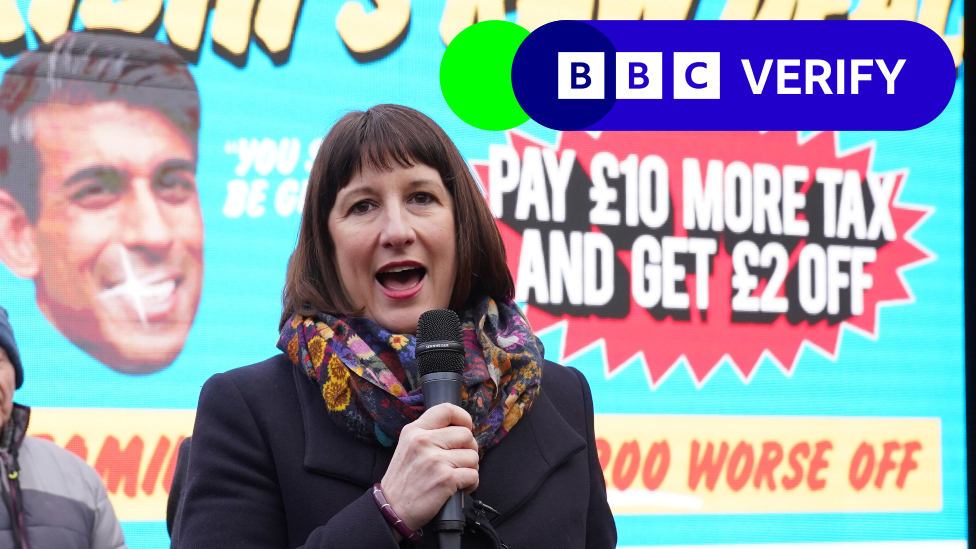Claims about tax changes fact-checked
- Published

Labour and the Conservatives have been making claims about what is happening to taxation.
At the start of what is widely expected to be an election year, they have been talking about the impact of tax changes on "average" workers and families.
We have been looking at some of their claims.
£1,200 extra tax for an average family?
Launching a new campaign poster on Friday 5 January, Labour's shadow chancellor Rachel Reeves said: "Working people are worse off under the Tories - £1,200 for an average family extra tax this year because of choices by Rishi Sunak and this Conservative government."
That is not correct. Labour have confirmed that she "misspoke".
She was talking about tax because National Insurance came down by 2p in the pound from 6 January 2024.
But the level of income at which people start paying tax has been frozen - since July 2022 for National Insurance and since April 2021 for income tax.
Where does the £1,200 come from?
Labour confirmed that the £1,200 figure came from research by the Resolution Foundation, external, focusing on living standards.
The independent think tank said in November 2023 that taxes would rise £1,200 per household by 2028-29 - not this year.
This is based on the November predictions by the Office for Budget Responsibility, external (OBR), which makes forecasts for the government:
The personal tax rises announced between March 2021 and November 2022 would raise £44.6bn in 2028-29
The 2p in the pound cut in National Insurance offsets £10bn of this to give £34.6bn
If you divide that by the number of households, external (currently 28.2 million) you get just over £1,200.
Of course, not every household will pay £1,200. Richer households will pay significantly more - poorer households much less.
So what is happening this year?
For an employee on average full-time earnings of about £35,000, the two factors roughly cancel each other out this year, according to, external the independent economic think-tank, the Institute for Fiscal Studies (IFS).
That will not be the case for all workers. Some of those on lower incomes will lose out - some higher earners will gain more than they lose. The IFS says that it is a tax rise overall this year.
It is in later years that the increases in taxes outweigh the National Insurance cut for the average earner, as more people start paying tax and start paying higher rates of tax.
Paying £10 and getting back £2?
On Friday 26 January, Rachel Reeves tweeted, external: "Under Rishi Sunak's Raw Deal, for every extra £10 you pay in tax, you only get £2 back."
That was also the message on the poster from earlier in the month, but again it refers to forecasts for 2028-29 and not the current situation.
It's another calculation based on the OBR forecasts from November, external.
As mentioned before, the tax increases are predicted to raise an extra £44.6bn in 2028-29 while the cut in National Insurance costs the government £10bn that year.
It means that the tax cut is worth just under a quarter of the increase, which Labour has rounded down to paying an extra £10 and getting £2 back.
Clearly that's not true for every taxpayer - it's an average. The actual impact will depend on income levels.
Will the average earner save £450?
Prime Minister Rishi Sunak spoke about tax cuts in an interview on Friday 5 January. He said: "We're in a position where we can cut people's taxes. So for a typical parent in work earning £35,000, the average salary, then they will get a tax cut worth £450."
He's right about the £450 but he is ignoring the effect of the previous tax measures, some of which come into force this year.
Here's where the £450 comes from:
The threshold to start paying National Insurance is £12,570
That means our employee on £35,000 (the average salary for full-time employees) pays National Insurance on £22,430 of it
Instead of paying National Insurance at 12% they will be paying it at 10%, so paying £2243 instead of £2692, which is a difference of £449.
But if the freeze on tax thresholds is taken into account, as we have already mentioned, that average earner will just about break even, according to the IFS.
Their analysis finds that even if only the freeze on tax thresholds this April is taken into account (as opposed to freezes going back to 2021), the average earner will still only be £130 better off.
Some of the points at which people start having to pay other rates of income tax in Scotland will be increasing in April.

